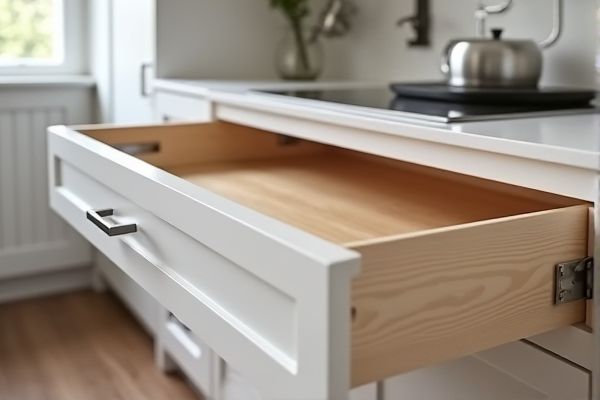
Soft-close drawers gently slow down as they close, preventing slamming and extending the lifespan of both the drawer and its contents, while self-close drawers automatically pull themselves shut from a certain distance to ensure closure without manual effort. Explore the key differences and benefits of each type to determine which drawer closure system best suits your needs.
Table of Comparison
| Feature | Soft-Close Drawers | Self-Close Drawers |
|---|---|---|
| Closing Mechanism | Hydraulic dampers slow and cushion drawer closing | Spring-loaded or gravity-assisted pulls drawer closed |
| Noise Level | Quiet and smooth closing | May produce a clicking or snapping sound |
| User Effort | Requires moderate push to engage soft-close | Minimal push needed; drawer self-closes once near shut |
| Durability | Long-lasting hydraulic components | Springs may wear out faster than hydraulics |
| Cost | Higher initial cost due to hydraulic system | Lower cost, simpler mechanism |
| Common Use | Premium cabinetry, kitchens, bathrooms | Budget furniture, office drawers |
Introduction to Soft-Close and Self-Close Drawers
Soft-close drawers use hydraulic mechanisms to gently slow and stop the drawer, preventing slamming and reducing wear on your furniture. Self-close drawers incorporate spring or spring-assisted systems that automatically pull the drawer shut once pushed past a certain point, enhancing convenience. Both options improve drawer functionality, with soft-close prioritizing silent closing and self-close emphasizing hands-free closure.
How Soft-Close Drawer Mechanisms Work
Soft-close drawer mechanisms use hydraulic or pneumatic dampers to slow the drawer's movement as it closes, preventing slamming and reducing wear on your cabinetry. These systems engage when the drawer is pushed gently past a certain point, activating a controlled, quiet close that enhances durability and user experience. Understanding how soft-close technology works helps you choose between standard self-close or advanced cushioning features for your furniture.
Understanding Self-Close Drawer Technology
Self-close drawer technology utilizes mechanical or hydraulic mechanisms that automatically pull the drawer shut once it reaches a certain point, preventing slamming and reducing wear. Unlike soft-close systems that slow the drawer at the final stage for a gentle close, self-close drawers rely more on the drawer's momentum to finish closing securely. Understanding this distinction helps you choose the right drawer system based on your desired blend of convenience and noise reduction.
Key Differences Between Soft-Close and Self-Close Drawers
Soft-close drawers gently slow down and quietly close the drawer as it nears the end of its movement, preventing slamming and reducing wear on the hardware. Self-close drawers pull themselves fully closed after reaching a certain point, ensuring the drawer is completely shut without requiring force from You. The key differences lie in the closing mechanism: soft-close focuses on smooth, silent closure, while self-close emphasizes automatic completion of the closing action.
Pros and Cons of Soft-Close Drawers
Soft-close drawers provide a smooth and quiet closing experience, reducing noise and preventing damage from slamming, which extends the lifespan of cabinetry. They require more complex mechanisms and higher installation costs compared to standard drawers, potentially increasing maintenance needs. While enhancing convenience and safety, soft-close drawers may not close fully if pushed too softly, posing minor usability challenges.
Advantages and Disadvantages of Self-Close Drawers
Self-close drawers offer the advantage of automatic closing without slamming, reducing noise and preventing damage to the drawer and contents. They enhance convenience by eliminating the need for manual pushing but can be prone to mechanical failure over time, requiring maintenance or replacement. The primary drawback is the increased cost and complexity compared to traditional drawers, potentially limiting their use in budget-conscious projects.
Durability and Maintenance Factors
Soft-close drawers feature hydraulic mechanisms that reduce wear and tear, enhancing durability by preventing slamming and minimizing noise. Self-close drawers rely on mechanical springs or rollers, which may require more frequent adjustments or replacements due to higher stress on components. Your maintenance efforts will be lower with soft-close systems, as their controlled closing action preserves hardware longevity and cabinet integrity.
Cost Comparison: Soft-Close vs Self-Close Drawers
Soft-close drawers generally cost more than self-close drawers due to their advanced dampering mechanisms that provide a quieter, smoother closing experience. Self-close drawers use simpler spring or mechanical systems, making them more affordable but less efficient in noise reduction and cushioning. Choosing soft-close drawers results in higher upfront expenses but offers enhanced durability and user comfort over time.
Installation Requirements for Each Type
Soft-close drawers require precise alignment and installation of hydraulic dampers or soft-close mechanisms to ensure smooth, quiet closing, often necessitating additional hardware and careful adjustment. Self-close drawers utilize a mechanical catch and spring system integrated into the drawer slides, which generally involve simpler installation with standard drawer slide components. Both types demand accurate measurement and compatibility with existing cabinetry to achieve optimal functionality and longevity.
Which Drawer System is Best for Your Space?
Soft-close drawers use hydraulic dampers to gently slow and stop the drawer, preventing slamming and reducing wear on cabinetry. Self-close drawers, often spring-loaded, automatically pull the drawer shut once it's nearly closed, ensuring a secure fit without manual effort. Your choice depends on whether you prioritize quiet, smooth closure or convenience and speed in everyday use.
 homyna.com
homyna.com